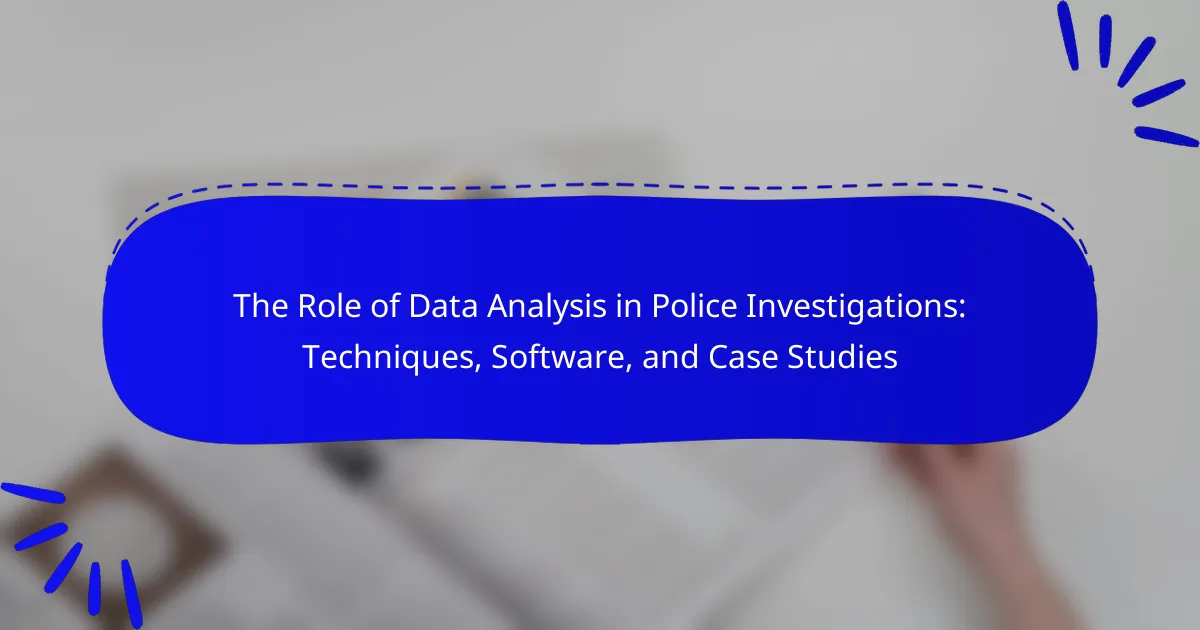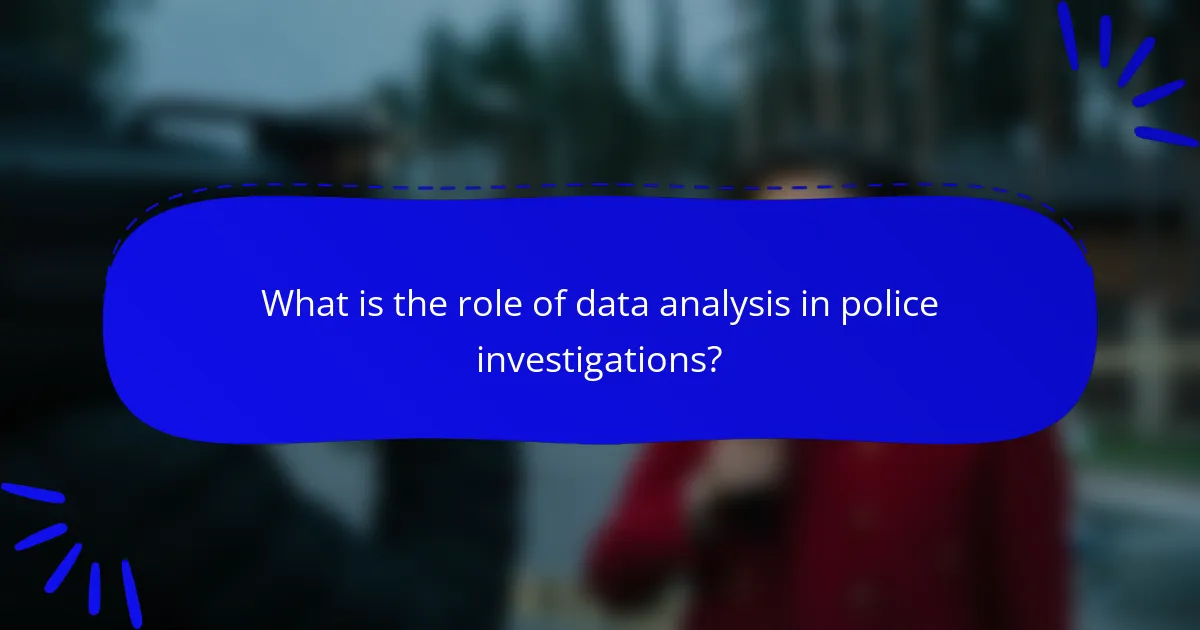
What is the role of data analysis in police investigations?
Data analysis plays a crucial role in police investigations. It helps law enforcement agencies identify patterns and trends in criminal behavior. By analyzing data, investigators can link crimes to specific suspects or locations. This process often involves the use of software tools that visualize complex data sets. For example, geographic information systems (GIS) can map crime hotspots. Additionally, data analysis can assist in resource allocation, ensuring officers are deployed where they are most needed. Historical data can also aid in predicting future criminal activity. Overall, data analysis enhances the efficiency and effectiveness of police work.
How does data analysis enhance investigative processes?
Data analysis enhances investigative processes by providing actionable insights from large volumes of data. It identifies patterns and trends that may not be visible through traditional methods. Investigators can use statistical techniques to uncover correlations between different pieces of evidence. This process helps prioritize leads based on data-driven assessments. For example, predictive analytics can forecast potential criminal activities. Additionally, data visualization tools facilitate the interpretation of complex information. A study by the International Association of Chiefs of Police found that data-driven policing strategies led to a 30% reduction in crime rates in certain jurisdictions. Thus, data analysis significantly improves the efficiency and effectiveness of investigations.
What specific data analysis techniques are commonly used in police work?
Common data analysis techniques used in police work include crime mapping, predictive analytics, and social network analysis. Crime mapping visualizes crime data geographically to identify hotspots. Predictive analytics uses historical data to forecast future crime trends. Social network analysis examines relationships between individuals to uncover criminal networks. These techniques enhance situational awareness and resource allocation in law enforcement. For instance, the Chicago Police Department utilizes predictive analytics to allocate patrols effectively. Additionally, crime mapping tools like ArcGIS help visualize crime patterns, enabling targeted interventions.
How do these techniques improve case outcomes?
Data analysis techniques improve case outcomes by enhancing the accuracy of investigations. These techniques allow for the identification of patterns in criminal behavior. They facilitate the correlation of evidence across different cases. This correlation can lead to quicker identification of suspects. Additionally, data analysis helps allocate resources more effectively. By analyzing crime trends, law enforcement can focus on high-risk areas. Studies show that data-driven policing can reduce crime rates by up to 30%. Improved case outcomes stem from informed decision-making based on solid evidence.
Why is data analysis crucial for modern policing?
Data analysis is crucial for modern policing because it enhances decision-making and resource allocation. Law enforcement agencies use data to identify crime patterns and trends. This allows for proactive measures to prevent crime. For example, predictive policing algorithms analyze historical crime data to forecast potential hotspots. Studies show that departments using data analysis have seen reductions in crime rates. A report from the Police Executive Research Forum highlights that data-driven strategies improve community safety. Additionally, data analysis aids in solving cases by linking evidence and suspects. Overall, it transforms policing from reactive to proactive strategies, improving public safety outcomes.
What challenges do law enforcement agencies face without data analysis?
Law enforcement agencies face significant challenges without data analysis. These challenges include inefficient resource allocation, as officers may not know where to focus their efforts. Crime patterns can go unnoticed, leading to missed opportunities for prevention. Investigations may become prolonged due to a lack of insights from historical data. Additionally, agencies may struggle to identify suspects or solve cases without data-driven leads. Communication and collaboration between departments can suffer, resulting in fragmented efforts. Overall, the absence of data analysis hinders effective crime fighting and community safety.
How has the evolution of crime data impacted police investigations?
The evolution of crime data has significantly enhanced police investigations. Advanced data analytics allows law enforcement to identify crime patterns more effectively. This leads to targeted resource allocation and proactive policing strategies. Historical crime data analysis can reveal trends that inform future investigations. Geographic Information Systems (GIS) help visualize crime hotspots. Predictive policing tools forecast potential criminal activity based on data. Studies show that agencies using data-driven approaches report increased case clearance rates. For example, the Los Angeles Police Department utilized crime data to reduce violent crime by 30% over five years.
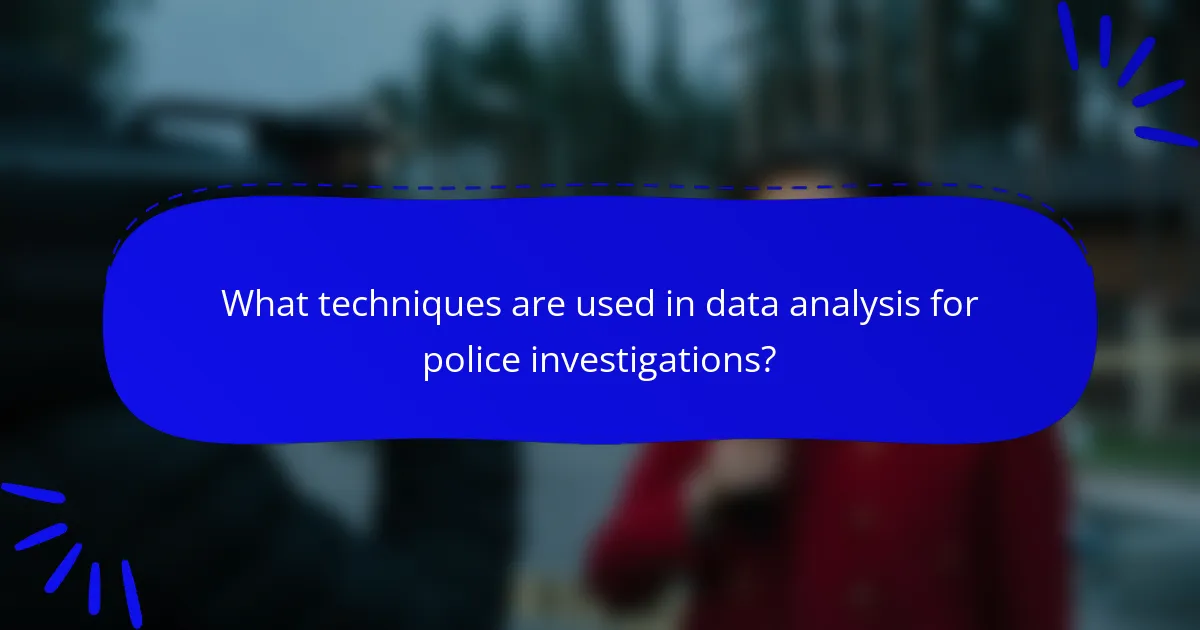
What techniques are used in data analysis for police investigations?
Data analysis in police investigations employs various techniques. These techniques include statistical analysis, which helps identify crime patterns. Predictive policing uses algorithms to forecast potential criminal activities. Geographic information systems (GIS) visualize crime data spatially. Social network analysis examines relationships between individuals involved in crimes. Data mining extracts useful information from large datasets. Machine learning algorithms enhance the accuracy of crime prediction models. Each of these techniques supports law enforcement in making data-driven decisions.
How do predictive analytics contribute to crime prevention?
Predictive analytics contribute to crime prevention by analyzing data to identify potential criminal activity before it occurs. Law enforcement agencies utilize historical crime data to forecast where and when crimes are likely to happen. This approach allows for resource allocation to high-risk areas, enhancing police presence and surveillance. Studies have shown that cities employing predictive policing techniques have experienced reductions in crime rates. For instance, the Los Angeles Police Department reported a 30% decrease in property crime using predictive analytics. By leveraging algorithms and statistical models, police can make informed decisions that proactively address crime trends.
What are the key algorithms used in predictive analytics?
Key algorithms used in predictive analytics include linear regression, decision trees, and neural networks. Linear regression models the relationship between variables to predict outcomes. Decision trees segment data into branches for classification and regression tasks. Neural networks simulate human brain functions to identify patterns in complex datasets. These algorithms are widely applied in various fields, including law enforcement for crime prediction and resource allocation. Their effectiveness is supported by numerous studies demonstrating improved accuracy in predictions when utilizing these methods. For instance, the use of decision trees in crime analysis has shown a 20% increase in prediction accuracy compared to traditional methods.
How can predictive analytics be integrated into daily police operations?
Predictive analytics can be integrated into daily police operations by utilizing data-driven approaches to forecast crime trends. This involves collecting and analyzing historical crime data, demographic information, and social factors. Police departments can use algorithms to identify hotspots where crimes are likely to occur. For instance, the Los Angeles Police Department employs predictive policing software to allocate resources effectively.
Additionally, officers can receive alerts about potential crime patterns based on real-time data analysis. Research indicates that departments using predictive analytics have seen a reduction in crime rates. A study by the RAND Corporation found that predictive policing led to a 10-20% decrease in certain types of crime. This integration enhances proactive policing strategies and improves community safety.
What role does spatial analysis play in investigations?
Spatial analysis plays a crucial role in investigations by helping to visualize and interpret geographic data. It enables law enforcement to identify patterns and trends related to criminal activity. By mapping incidents, investigators can pinpoint hotspots where crimes frequently occur. This information aids in resource allocation and strategic planning for patrols. Additionally, spatial analysis facilitates the examination of relationships between different variables, such as time and location of crimes. Studies have shown that geographic information systems (GIS) significantly enhance the effectiveness of crime analysis. For instance, the National Institute of Justice highlights how spatial analysis can reduce crime rates through informed decision-making.
How does geographic information systems (GIS) enhance crime mapping?
Geographic Information Systems (GIS) enhance crime mapping by providing spatial analysis tools. These tools allow law enforcement to visualize crime patterns geographically. GIS can analyze data by location, facilitating the identification of crime hotspots. It integrates various data sources, including demographic and environmental factors. This integration helps in understanding the context of criminal activity. For example, a study by the National Institute of Justice found that GIS can improve resource allocation in policing. Additionally, GIS enables predictive policing by forecasting potential crime occurrences. This capability enhances proactive law enforcement strategies. Overall, GIS significantly improves the effectiveness of crime mapping and analysis.
What are the benefits of using spatial analysis in resource allocation?
Spatial analysis enhances resource allocation by optimizing decision-making. It allows for the visualization of data in geographic contexts. This helps identify patterns and trends in resource distribution. By analyzing spatial relationships, organizations can allocate resources more effectively. For example, police departments can deploy officers based on crime hotspots. Studies show that targeted resource allocation reduces response times. Additionally, spatial analysis supports strategic planning and resource management. Overall, it leads to more efficient use of resources and improved public safety outcomes.
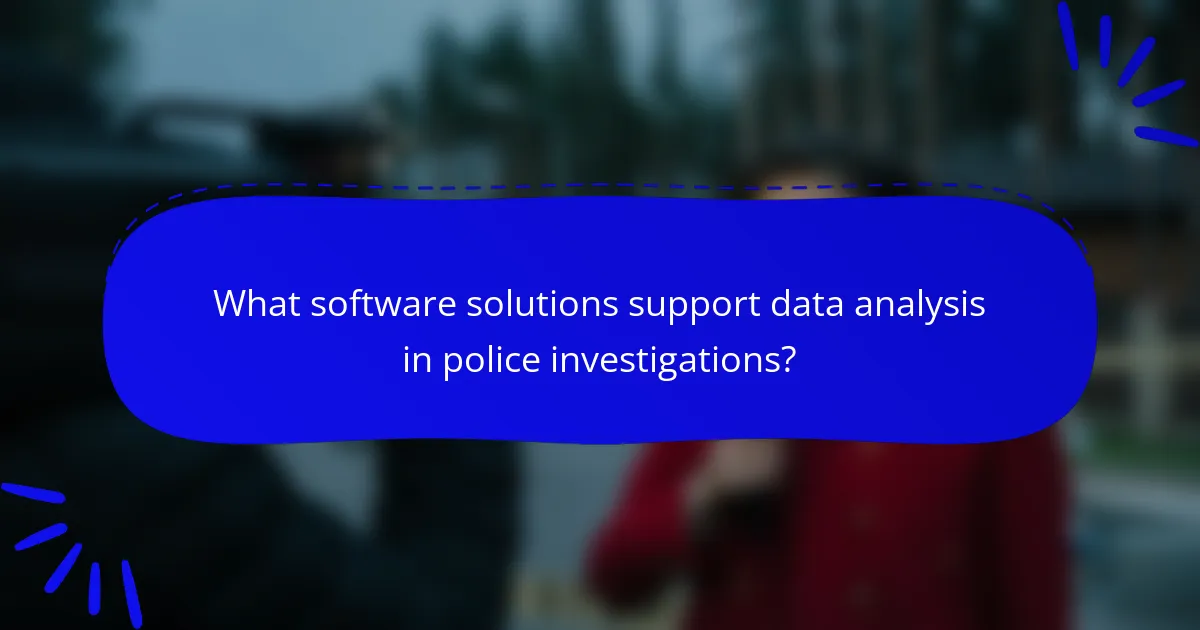
What software solutions support data analysis in police investigations?
Software solutions that support data analysis in police investigations include IBM i2 Analyst’s Notebook, Palantir, and SAS. These tools help law enforcement agencies analyze complex data sets. IBM i2 Analyst’s Notebook provides visualization capabilities for connecting data points. Palantir offers advanced analytics and data integration features. SAS specializes in statistical analysis and predictive modeling. Each software enhances the ability to uncover patterns and insights. Their use has been documented in various case studies, demonstrating effectiveness in solving crimes.
What are the most popular data analysis software used by law enforcement?
The most popular data analysis software used by law enforcement includes IBM i2 Analyst’s Notebook, Palantir, and SAS. IBM i2 Analyst’s Notebook is widely recognized for its advanced link analysis capabilities. Palantir is known for its robust data integration and visualization features. SAS provides powerful analytics and predictive modeling tools. These software solutions help law enforcement agencies analyze data efficiently and effectively. Their popularity stems from their ability to enhance investigative processes and improve decision-making.
How do these software solutions differ in functionality?
Different software solutions for data analysis in police investigations vary in functionality based on their analytical capabilities, user interface, and integration options. Some solutions focus on predictive analytics, helping law enforcement anticipate criminal activity by analyzing historical data patterns. Others may prioritize real-time data processing, allowing officers to access and analyze information on-the-go during investigations.
Additionally, certain software offers advanced visualization tools, enabling users to create detailed maps and charts for better case presentations. Integration capabilities also differ; some platforms can seamlessly connect with existing law enforcement databases, while others may require manual data entry.
For example, software like IBM i2 Analyst’s Notebook excels in link analysis, highlighting connections between individuals and events. In contrast, tools like Palantir provide robust data integration and collaboration features, suited for multi-agency investigations. Each software solution’s unique attributes cater to specific needs within police investigations, enhancing overall effectiveness.
What are the key features to look for in data analysis software?
Key features to look for in data analysis software include user-friendliness, data visualization capabilities, and integration options. User-friendliness ensures that law enforcement personnel can easily navigate the software without extensive training. Data visualization capabilities allow users to present complex data in a clear and understandable manner. Integration options enable the software to work seamlessly with other tools and databases used in police investigations. Additionally, robust data security features are essential to protect sensitive information. Scalability is important to accommodate growing data needs. Lastly, customer support can enhance the user experience by providing assistance when needed. These features collectively enhance the effectiveness of data analysis in police investigations.
How can law enforcement agencies implement data analysis software effectively?
Law enforcement agencies can implement data analysis software effectively by establishing clear objectives and requirements. They should assess their specific needs to choose the right software that aligns with their goals. Training personnel is crucial to ensure users understand the software’s functionalities. Regular updates and maintenance of the software are necessary for optimal performance. Collaboration with IT experts can enhance integration with existing systems. Agencies should also prioritize data security and compliance with legal standards. Evaluating the software’s effectiveness through metrics will help in refining its use. Research indicates that effective implementation can lead to improved crime analysis and resource allocation.
What training is necessary for officers to utilize data analysis tools?
Officers require specialized training to effectively utilize data analysis tools. This training typically includes courses in data interpretation and statistical methods. Officers learn to use software applications designed for data analysis. Familiarity with databases and data visualization techniques is also essential. Additionally, training often covers legal and ethical considerations in data handling. Practical exercises help reinforce the skills learned in theory. For instance, simulations may be used to apply data analysis in real-world scenarios. This comprehensive approach ensures officers can make informed decisions based on data insights.
How can agencies ensure data integrity and security during analysis?
Agencies can ensure data integrity and security during analysis by implementing strict access controls. Limiting access to sensitive data helps prevent unauthorized modifications. Regular audits of data access and usage can identify potential security breaches. Encryption of data during transmission and storage protects it from interception. Utilizing secure software tools enhances the reliability of data analysis processes. Training personnel on data security protocols reduces human error risks. Adopting best practices in data governance promotes accountability and compliance. These measures collectively reinforce the integrity and security of data throughout the analysis phase.
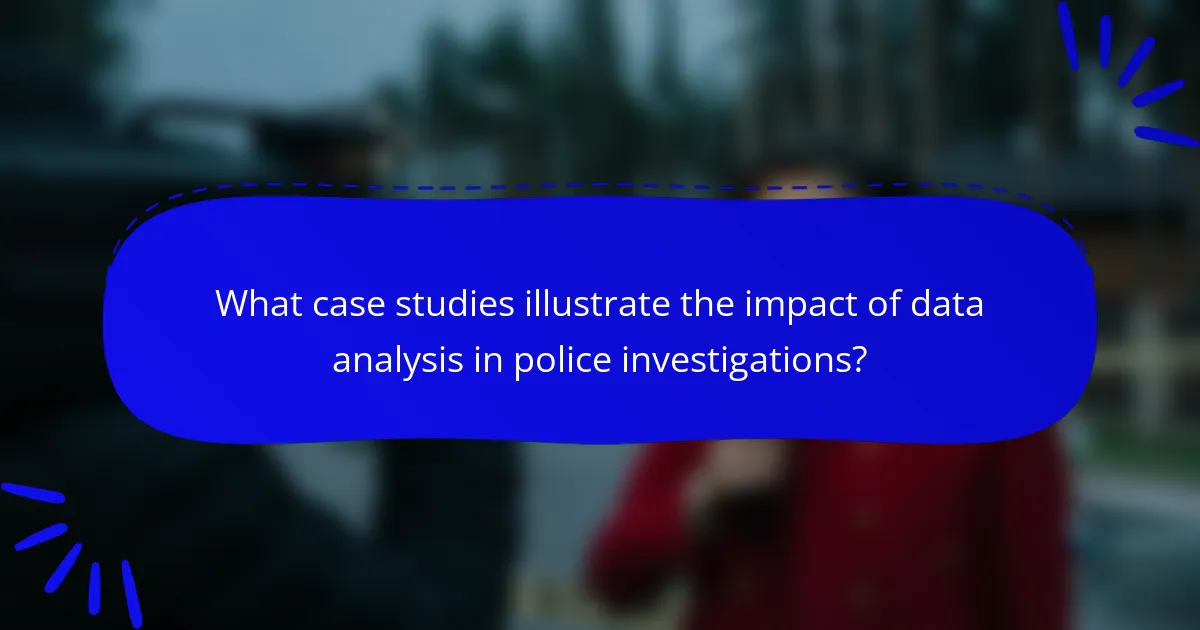
What case studies illustrate the impact of data analysis in police investigations?
Data analysis has significantly impacted police investigations, as illustrated by several case studies. One notable case is the 2002 Washington, D.C. sniper attacks. Law enforcement used data analysis to track the patterns of the shootings. This analysis helped narrow down the search area and ultimately led to the arrest of the suspects.
Another example is the use of predictive policing in Los Angeles. The LAPD implemented data analysis to forecast crime hotspots. This approach resulted in a reduction of property crimes by over 10% in targeted areas.
In the case of the 2013 Boston Marathon bombing, investigators utilized data analysis to sift through thousands of hours of video footage. This led to the identification of the suspects within days of the attack.
These case studies demonstrate the effectiveness of data analysis in enhancing the efficiency and accuracy of police investigations.
What are some notable examples of successful data-driven investigations?
Notable examples of successful data-driven investigations include the Boston Marathon bombing case and the Golden State Killer case. In the Boston Marathon bombing, investigators analyzed video footage and social media data to identify suspects. This approach led to the quick identification of Tamerlan and Dzhokhar Tsarnaev.
In the Golden State Killer investigation, genealogical data from public DNA databases helped link Joseph DeAngelo to multiple cold cases. This innovative use of data led to his arrest in 2018 after decades of investigation.
Both cases illustrate the effectiveness of data analysis in solving complex criminal cases. Data-driven techniques have transformed traditional investigative methods, yielding significant results.
How did data analysis change the outcome of these cases?
Data analysis significantly altered the outcomes of various police investigations. It enabled law enforcement to identify patterns and connections in criminal activities. For example, predictive analytics helped prioritize resources in high-crime areas. In one case, data analysis led to the identification of a serial offender through crime pattern recognition. This approach reduced investigation time and increased the likelihood of apprehending suspects. Additionally, data visualization tools facilitated clearer communication of findings among investigators. Ultimately, data analysis improved case resolution rates and enhanced public safety.
What lessons were learned from these case studies?
Case studies in police investigations reveal several crucial lessons. Effective data analysis enhances investigative efficiency. It helps identify patterns and trends in criminal behavior. Utilizing advanced software tools improves data processing speed. Collaboration between departments leads to more comprehensive insights. Training officers in data analysis techniques is essential for successful implementation. Real-time data access aids in timely decision-making. Lastly, maintaining data integrity is vital to ensure accuracy in investigations.
What best practices can be adopted from these case studies?
Best practices from these case studies include implementing data-driven decision-making in investigations. Utilizing advanced analytics tools enhances evidence identification and case resolution. Regular training on software usage improves officer proficiency. Collaboration between departments fosters information sharing and resource optimization. Establishing clear protocols for data collection ensures consistency and reliability. Engaging with community stakeholders builds trust and improves data quality. Continuous evaluation of data analysis methods helps refine investigative techniques. These practices lead to more efficient and effective police investigations.
How can police departments foster a culture of data-driven decision-making?
Police departments can foster a culture of data-driven decision-making by implementing structured data analysis practices. They should invest in training officers and staff on data analytics tools. Regular workshops can enhance understanding of data interpretation. Establishing clear data collection protocols is essential for consistency. Encouraging collaboration between data analysts and police personnel can improve insights. Leadership should prioritize data usage in strategic planning. Transparency in sharing data findings promotes trust within the department. Research shows that departments utilizing data-driven approaches report improved crime reduction rates. For example, the New York Police Department’s CompStat has effectively reduced crime through data analysis.
What common pitfalls should be avoided in data analysis for policing?
Common pitfalls to avoid in data analysis for policing include misinterpretation of data, inadequate data quality, and confirmation bias. Misinterpretation occurs when analysts draw incorrect conclusions from the data. This can lead to misguided strategies or policies. Inadequate data quality can stem from incomplete or inaccurate information, which undermines the analysis’s reliability. Confirmation bias happens when analysts favor data that supports preconceived notions, ignoring contradictory evidence. These pitfalls can result in ineffective policing strategies and wasted resources. Awareness and training in data analysis can help mitigate these issues.
The main entity of the article is data analysis in police investigations. The article provides an overview of the critical role that data analysis plays in enhancing the effectiveness of law enforcement operations, including identifying crime patterns, improving resource allocation, and facilitating proactive policing strategies. Key techniques discussed include crime mapping, predictive analytics, and social network analysis, alongside popular software solutions such as IBM i2 Analyst’s Notebook and Palantir. The article also highlights notable case studies that demonstrate the impact of data analysis on solving crimes and improving public safety outcomes, while addressing challenges and best practices for effective implementation in police departments.
